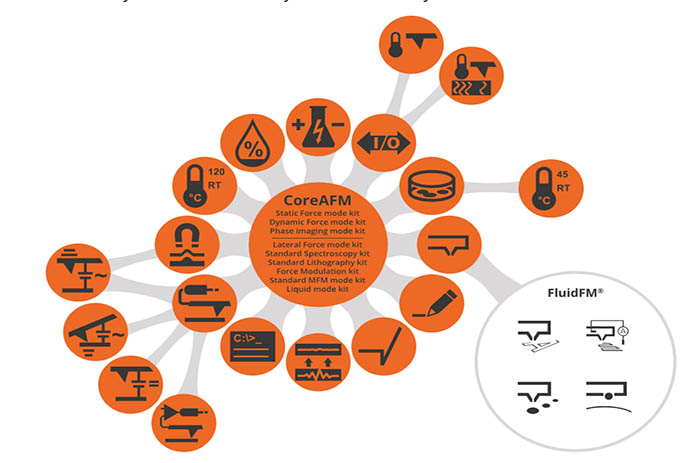| The minimalist and integrated design approach eliminates the need for cables and connectors between the scanner and controller, additional controller casing, air-flow protection, camera housing, and so on, thus making every remaining component essential to its function. Less is more — in case of the CoreAFM this means more value for your money.
The CoreAFM and its accessories have been designed as part of a consistent system concept.  Example of the thought and design processes that went into the development of the CoreAFM and its accessories, all leading to lower overall costs and higher reusability
The result is an integrated, high-quality, high-performance, and versatile AFM system that offers the best price-to-performance in the market. An atomic force microscope that is easy to use, robust, and easily extendable. The CoreAFM brings you back to the essence of AFM: the measurement, not the machine! Compact and completeThe fusion of a modern flexure-guided scanner, a fully digital 32-bit controller, XYZ sample stage, camera, and air-flow protection in a single all-in-one unit results in a complete AFM system with an unparalleled compact footprint. All the essential functions of modern AFM are integral components of the CoreAFM system; thus, only connecting power and USB is all that is needed for a fully operational CoreAFM.
Powerful and versatileState of the art electronics with 24-bit ADC and DAC ensure high-resolution XYZ driving of the 100×100×12 µm scanner and allow for low-noise force detection limited only by the cantilever. Thirty-two standard and optional modes with fully compatible add-ons make the CoreAFM the tool of choice for applications ranging from materials research to life science and electrochemistry. Starting from the basic CoreAFM system, its functionality can be seamlessly extended.
Deeper system integration of the Isostage is reflected in the unique SpikeGuard, which eliminates glitches during imaging. Although the Isostage is an active vibration isolation system, glitches can still occur when distortions are too severe. SpikeGuard detects such anomalies and rescans the line for a distortion-free image. Included measurement modesThe CoreAFM can perform Static force, Dynamic force, Phase imaging, MFM, Lateral force, Force modulation, Standard spectroscopy, and Standard lithography out of the box. You can however enhance your measurement experience with CoreAFM mode kits. Included standard mode kitsBy default, the CoreAFM comes with the Static force mode kit, Dynamic force mode kit, and Phase imaging mode kit to get you started right away. Depending on the measurement mode, a mode kit may include samples, suitable cantilevers, accessories, or a combination thereof. Additional standard mode kitsAdditional standard-level mode kits that can be acquired separately are the Standard spectroscopy kit, Standard lithography kit, Standard MFM mode kit, Standard liquid kit, Lateral force mode kit, and Force modulation kit. Advanced functionalityAdvanced AFM modes and functionality like sample heating, environmental control, scripting, and many others can easily be added to your CoreAFM. Similar to the standard modes these functionalities come with mode kits (see for example the EFM mode kit). Besides samples, cantilevers and/or accessories these kits may also contain software keys. For details and dependencies, see the overview graphic above and the primary and secondary add-on lists in the sidebar. System specifications
|
Discount Products: Look through products available for a 25% – 50% discount in 2020. The items provided on a first come, first serve basis. View Discounted Products




